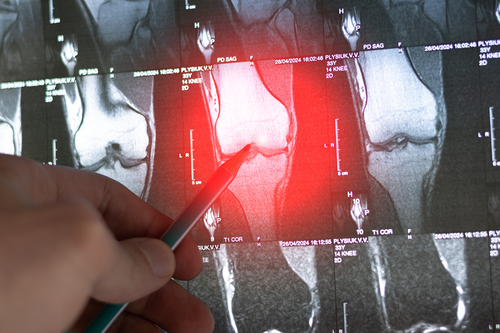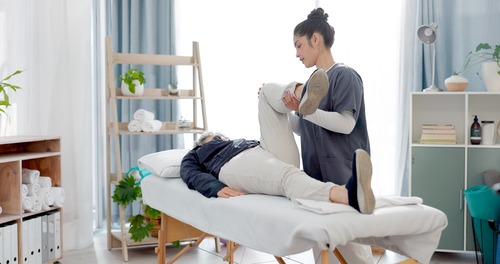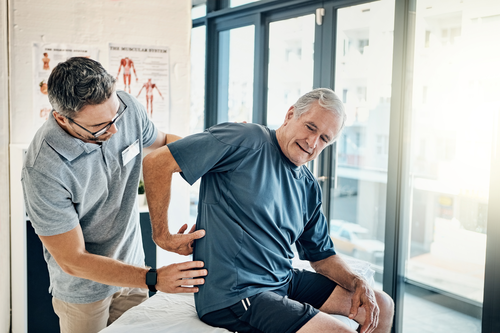Bone-on-bone knee pain, often caused by advanced knee osteoarthritis, can severely impact your quality of life. Simple activities like walking, climbing stairs, or even getting out of a chair can become painful challenges. While surgery is sometimes recommended for severe cases, many individuals seek non-surgical options to manage their pain and maintain their mobility. Fortunately, several effective strategies don’t involve going under the knife.
In this blog, we’ll explore various non-surgical treatments that can help manage bone-on-bone knee pain, ranging from lifestyle changes to advanced therapies.
Understanding Bone-on-Bone Knee Pain
Arthritis pain, particularly bone-on-bone knee pain, is a debilitating condition caused by the breakdown of cartilage in the knee joint, leading to persistent discomfort, inflammation, and reduced mobility.
What Causes Bone-on-Bone Knee Pain?
Bone-on-bone knee pain primarily results from osteoarthritis, a degenerative joint condition. Over time, the knee cartilage that serves as a cushion between the bones in your knee wears down. As this cartilage erodes, the bones lose their protective buffer and begin to grind against each other, causing pain, inflammation, and stiffness. This condition is more prevalent with age but can also be triggered by injury, overuse, or genetic predisposition.
Symptoms of Bone-on-Bone Knee Pain
The most common symptom of bone-on-bone knee pain is persistent joint pain that worsens with activity and improves with rest. Stiffness, especially after periods of inactivity, is also typical. Swelling and reduced range of motion are frequent complaints, making everyday tasks such as walking, bending, or climbing stairs more difficult. Some individuals may hear or feel a grating sensation when moving the knee.
How Bone-on-Bone Knee Pain Impacts Mobility
The deterioration of cartilage not only leads to pain but also affects overall mobility. With the loss of this cushioning, every step creates friction between the bones, limiting flexibility and contributing to an altered gait. Over time, the muscles surrounding the knee weaken, further reducing the joint’s stability. This cycle of pain and immobility can significantly impact a person’s quality of life, making it difficult to maintain an active lifestyle. Therefore, incorporating strengthening activities is crucial for alleviating knee pain and improving mobility.
Why Early Intervention Matters
Addressing bone-on-bone knee pain early is crucial to maintaining joint function and mobility. When left untreated, the damage can worsen, leading to increased pain and possible deformity of the joint. Early intervention with non-surgical treatments can help alleviate pain, slow the progression of osteoarthritis, and delay or potentially eliminate the need for surgery. Treating knee pain effectively involves understanding the underlying causes and implementing various therapeutic options, including physical therapy and lifestyle changes.
Non-Surgical Treatment Options
When dealing with bone-on-bone knee pain, several non-surgical knee pain treatments can effectively reduce discomfort, improve mobility, and help manage symptoms without the need for invasive procedures.
Low-Impact Exercise
Engaging in low-impact exercises can help relieve knee pain by strengthening the muscles that support the knee joint. Activities like swimming, cycling, yoga, and walking can improve flexibility, reduce stiffness, and promote joint stability without placing excessive strain on the knees. Consistency is key, and even though initial discomfort may occur, regular movement often leads to long-term pain relief.
Weight Loss
Excess body weight places additional pressure on the knee joints, exacerbating pain and accelerating the degeneration of cartilage. Losing even a small percentage of body weight can significantly reduce knee pain by decreasing the mechanical load on the joint and reducing systemic inflammation. Weight loss is an effective non-surgical method for improving overall joint health and function.
Bracing
Knee braces can provide external stability to the knee joint, helping to realign the bones and reduce bone-on-bone contact. Bracing can minimize pain, improve mobility, and allow the joint to heal by limiting excessive movement. Braces are often used in conjunction with other treatments, such as physical therapy, to optimize recovery.
Physical Therapy
Physical therapy focuses on strengthening and stretching the muscles around the knee joint to reduce pain and enhance stability. Tailored exercise routines help restore range of motion, improve balance, and support the joint. Physical therapists also teach patients how to perform daily activities without aggravating their condition, making it a crucial component of long-term pain management.
Pain Medications
Over-the-counter pain relievers such as acetaminophen and ibuprofen are often used to manage mild to moderate knee pain. In more severe cases, prescription medications may be recommended. While medications provide temporary relief, they do not address the underlying cause of bone-on-bone knee pain and should be used as part of a broader treatment plan.
Injections
Corticosteroid and hyaluronic acid injections offer significant pain relief from knee pain by reducing inflammation and providing lubrication to the joint. While steroid injections can reduce inflammation for several months, hyaluronic acid helps restore the joint’s natural cushioning properties. These injections are commonly used when other treatments have failed to provide sufficient relief.
Nutraceuticals and Supplements
Supplements like glucosamine and chondroitin are often taken to support joint health. These nutraceuticals may help slow cartilage deterioration and reduce pain in some individuals. While results vary, many find them worth trying as a non-invasive option for managing knee pain. It is important to consult a healthcare provider before starting any supplements to ensure they are appropriate for your condition.
Lifestyle Modifications
Making small changes to your daily routine can reduce strain on the knees and help manage pain. Avoiding high-impact activities, using mobility aids, and modifying ergonomics at work or home can all contribute to long-term relief. These adjustments, combined with other treatments, can help improve the overall quality of life for those dealing with bone-on-bone knee pain.
Injection Therapies
When knee pain becomes unbearable and other non-surgical treatments aren’t providing enough relief, injection therapies offer a viable option compared to knee replacement surgery. These treatments are minimally invasive, designed to reduce inflammation, improve joint lubrication, and potentially even aid in healing. There are several types of injection therapies available, each with different mechanisms and benefits.
Corticosteroid Injections
Corticosteroid injections are among the most common treatments for knee pain. These injections deliver powerful anti-inflammatory medication directly into the knee joint. The primary goal is to reduce inflammation, which often significantly decreases pain. Relief can be felt as soon as 24 hours after the injection, though full effects typically develop within a few days. Results can last anywhere from three to six months, depending on the severity of the condition. However, it’s important to note that corticosteroid injections are not a long-term solution and may need to be repeated periodically.
Hyaluronic Acid Injections
Hyaluronic acid is a natural substance in joint fluid that provides lubrication and cushioning. When injected into the knee, hyaluronic acid acts as a shock absorber, reducing pain and potentially slowing down the progression of joint wear. This treatment is particularly beneficial for those with osteoarthritis as it helps the joint move more smoothly. However, the effects of hyaluronic acid injections may take several weeks to be felt and require multiple doses for the best results.
Orthobiologic Injections
Orthobiologic injections, part of regenerative medicine, are an emerging treatment option that aims to harness the body’s own healing abilities. These injections include platelet-rich plasma (PRP), bone marrow aspirate concentrate (BMAC), and placental tissue matrix therapy (PTMT). By injecting concentrated natural growth factors and cells into the knee, these treatments encourage tissue regeneration and healing. While the science behind orthobiologics is still evolving, early results suggest that they can reduce pain and improve knee function, especially when combined with other therapies like physical therapy.
Lifestyle Modifications
For those suffering from bone-on-bone knee pain, lifestyle modifications can be a critical part of managing symptoms and improving overall knee function, often delaying the need for knee replacement. Simple changes to daily habits and routines can reduce the strain on the knees and help in long-term pain relief. Below are the most effective lifestyle modifications to consider.
Low-Impact Exercises
Engaging in low-impact exercises is essential for maintaining joint mobility and strengthening the muscles that support the knee. Exercises such as swimming, cycling, and walking are ideal because they don’t place excessive pressure on the knee joint. Strength training can also help improve stability while stretching can increase flexibility. It’s important to maintain a regular exercise routine, aiming for 3-5 sessions per week. Consistency is key, as improvements often take several weeks to manifest.
Weight Loss
Excess weight puts additional stress on the knees, exacerbating pain and accelerating joint deterioration. Losing even a small amount of weight can significantly reduce knee pain. Every pound lost reduces the load on the knee by four pounds, making weight loss a powerful tool in managing knee pain. Beyond the mechanical benefits, losing weight can also reduce inflammation throughout the body, including the knees.
Activity Modification
Adapting daily activities to reduce strain on the knees is another important step. High-impact activities, such as running or jumping, should be avoided in favor of low-impact alternatives. Additionally, modifying how certain tasks are performed—such as using assistive devices or taking breaks during prolonged standing or walking—can minimize knee stress. These small adjustments can help prevent further damage to the knee joint and allow for more comfortable movement throughout the day.
See a Personal Injury Doctor ASAP to Discuss Your Knee Replacement Surgery Options!
If you’re struggling with bone-on-bone knee pain and are looking for effective non-surgical solutions, don’t wait to get the relief you need. Our team at Georgia Spine & Orthopaedics specializes in providing personalized care to help you manage pain and regain mobility.
Schedule a consultation today at 678-929-4494!






